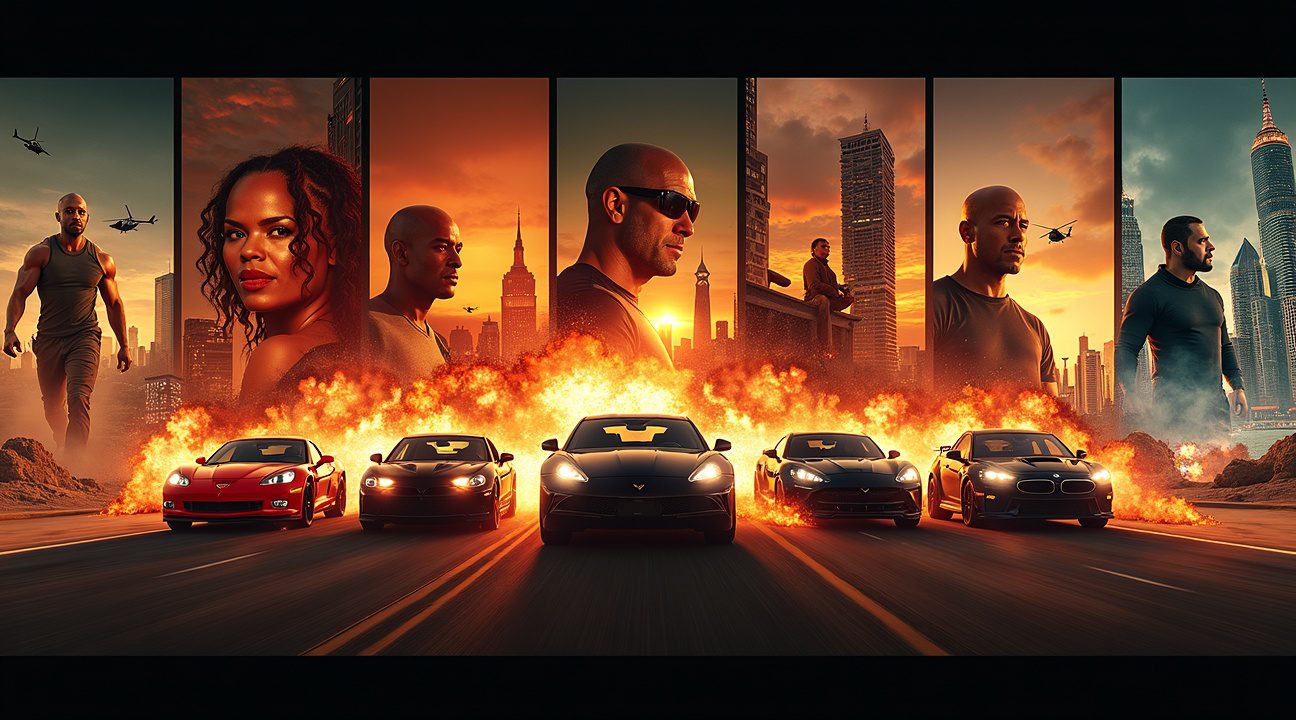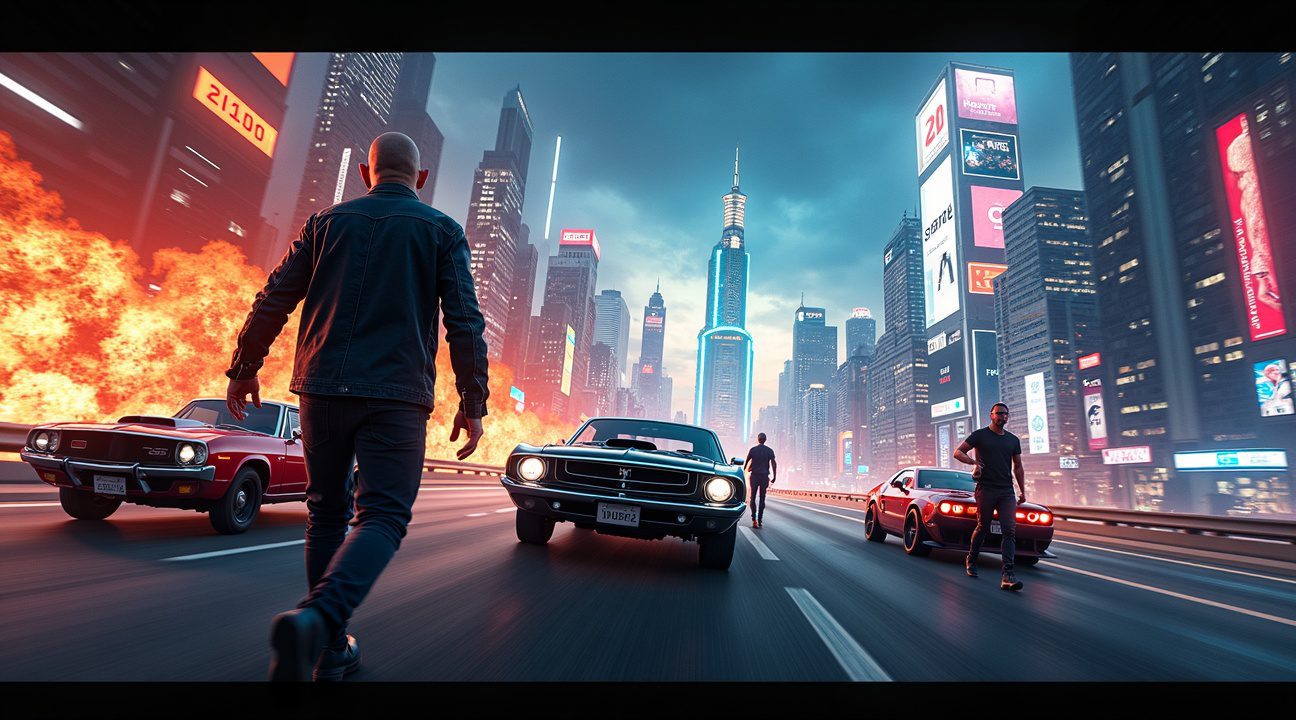Furious 7’s groundbreaking $1.51 billion worldwide earnings established the Fast and Furious franchise as a global entertainment juggernaut, with international markets driving approximately 80% of its massive revenue through a strategic evolution from street racing films to globe-trotting action spectacles.
The Fast and Furious franchise has undergone a remarkable transformation from its humble beginnings to become one of the most profitable properties in cinematic history. Launching with a modest $207 million box office debut, the series has since generated over $7.47 billion across numerous entries. This success is driven by a blend of spectacle, emotional storytelling, and international appeal.
Key Takeaways
- International dominance drives success – Overseas markets now account for 70–80% of total box office revenue, with countries like China often outperforming North America for individual installments.
- Strategic franchise evolution – Beginning with Fast Five in 2011, the franchise rebranded itself as a high-stakes, international action series, moving away from its origins in street racing culture.
- Emotional storytelling transcends spectacle – Themes surrounding family and the enduring legacy of the late Paul Walker have connected powerfully with fans, often overshadowing critical skepticism about over-the-top stunts.
- Record-breaking financial performance – Furious 7 reached the billion-dollar milestone in just 17 days. Two total franchise entries have surpassed $1 billion globally despite increasing production costs.
- Expanded universe potential – The brand continues to grow with success beyond the main saga. The spin-off Hobbs & Shaw raked in $761 million, showing that there’s plenty of room for future films, series, and even theme park collaborations.
The Fast and Furious saga remains a cultural phenomenon, blending adrenaline-fueled action with heartfelt connections, and expanding its legacy far beyond the finish line.
How Furious 7 Set an Unprecedented Record with $1.51 Billion Worldwide
I witnessed something extraordinary happen in 2015 when Furious 7 shattered every expectation and redefined what success looks like for action franchises. The film didn’t just break records—it obliterated them, becoming the highest-grossing entry in the entire Fast & Furious series with an astounding $1.51 billion worldwide earnings.
The numbers tell a compelling story of global dominance. While domestic markets in the U.S. and Canada contributed a solid $353 million, the real powerhouse performance came from international territories, where the film generated a staggering $1.16 billion. This split demonstrates how the franchise’s continued success relies heavily on its universal appeal across diverse cultures and markets.
What makes Furious 7‘s achievement even more remarkable is the speed at which it reached these milestones. The film crossed the $1 billion threshold in just 17 days, placing it among the fastest movies ever to achieve this feat. This rapid ascent showcased not only the franchise’s massive fanbase but also the emotional resonance of Paul Walker’s final complete performance, which drew audiences worldwide to theaters.
Breaking Down the Billion-Dollar Formula
The success of Furious 7 established a template that few films have managed to replicate. International markets proved absolutely crucial, accounting for roughly 77% of the film’s total gross. This pattern highlighted how overseas audiences had embraced the franchise’s blend of high-octane action, family themes, and spectacular set pieces that transcend language barriers.
Key factors contributing to this unprecedented success include:
- Emotional storytelling that honored Paul Walker’s legacy while delivering spectacular action sequences
- Strategic release timing across international markets to maximize global impact
- Advanced visual effects and practical stunts that created must-see cinema experiences
- Strong brand recognition built over seven previous films in the series
Only one other entry in the franchise has managed to join the billion-dollar club since then. The Fate of the Furious in 2017 earned $1.23 billion globally, proving that Furious 7‘s success wasn’t just a one-time emotional response but part of a sustainable formula for massive international appeal.
The ripple effects of Furious 7‘s record-breaking performance continue to influence how studios approach global blockbuster filmmaking. The film demonstrated that international markets could drive success even when domestic performance, while strong, represents a smaller portion of overall revenue. This shift in thinking has shaped everything from casting decisions to marketing strategies across the industry.
Current franchise totals reflect the lasting impact of this approach. As of 2024, the entire Fast & Furious series has generated $7.47 billion at the global box office, with Furious 7 representing more than 20% of that total. Recent entries continue to build on this foundation, though none have matched the cultural moment and box office performance that Furious 7 achieved.
The film’s success also influenced how other franchises approach international expansion. Studios began recognizing that overseas markets aren’t just additional revenue streams—they can be the primary drivers of a film’s financial success. This realization has led to more internationally-focused storytelling and marketing campaigns across multiple franchises.
Furious 7‘s billion-dollar milestone became a benchmark that few action films have reached since. The achievement stands as testament to the power of combining emotional storytelling with spectacular action, while demonstrating how global audiences respond when filmmakers create content that resonates across cultural boundaries. The record remains a defining moment not just for the franchise, but for understanding how modern blockbusters achieve worldwide success.
Why International Markets Drive 80% of the Franchise’s Massive Revenue
The Fast & Furious franchise has achieved extraordinary financial success by tapping into global audiences that extend far beyond its American origins. Recent installments demonstrate this international dominance clearly, with overseas markets contributing between 70-80% of total ticket sales. This shift represents a fundamental change in how blockbuster films generate revenue and highlights the franchise’s exceptional ability to resonate with diverse cultures worldwide.
China stands at the forefront of this international success story, often delivering box office numbers that dwarf domestic performance. The Chinese market has consistently embraced the franchise’s high-octane action sequences and family-centered themes, which align well with cultural values that prioritize loyalty and collective identity. Latin American and European audiences have similarly embraced the series, creating a global fanbase that studios increasingly depend upon for profitability.
Elements That Drive Universal Appeal
Several key factors contribute to the franchise’s remarkable overseas revenue performance:
- A multicultural cast that represents different ethnicities and backgrounds, making international audiences feel included and represented
- Filming locations that span continents, from Tokyo’s neon-lit streets to Rio de Janeiro’s favelas, showcasing global cities in spectacular fashion
- Action sequences that transcend language barriers, relying on visual spectacle rather than complex dialogue
- Universal themes of family, loyalty, and redemption that resonate across cultural boundaries
- Character arcs that celebrate diversity and international cooperation
The franchise’s commitment to featuring actors from various backgrounds has paid dividends in building authentic connections with global audiences. Ludacris’s insights about the franchise’s success emphasize how this inclusive approach has strengthened the series’ international appeal.
Production teams have strategically chosen filming locations that showcase iconic international destinations, creating tourism boosts for featured cities while simultaneously appealing to local audiences. When viewers see their home countries or neighboring regions represented on screen, they develop stronger emotional connections to the storylines. Fast X’s global scope continues this tradition by exploring new international settings that expand the franchise’s geographical reach.
The franchise’s impact extends beyond cinema into car culture and fashion trends worldwide. International markets have embraced the automotive customization culture popularized by the films, leading to increased sales of aftermarket parts and tuning services globally. Fashion choices worn by characters influence international style trends, particularly among younger demographics who view the films as lifestyle guides.
Studios have recognized this pattern and adapted their marketing strategies accordingly. International promotional campaigns often feature region-specific content that highlights local cast members or filming locations. These targeted approaches have proven more effective than generic worldwide campaigns, resulting in higher engagement rates and stronger box office performance.
The franchise’s ability to balance American sensibilities with international appeal has created a template for successful global entertainment. Rather than relying solely on American cultural references, the films incorporate international perspectives that make overseas audiences feel valued and understood. This approach has influenced how other major franchises approach international markets.
Box office analysts consistently point to the Fast & Furious series as an example of successful international franchise expansion. The films’ financial model now depends heavily on overseas performance, making international market reception more crucial than domestic reviews or ticket sales. This dependency has shifted creative decisions toward elements that enhance global appeal while maintaining the core identity that originally attracted audiences.
China’s box office contribution alone often exceeds the entire North American gross for individual installments, demonstrating the seismic shift in global entertainment consumption. European markets provide consistent revenue streams across multiple countries, while Latin American audiences have shown remarkable loyalty to the franchise’s extended universe. Celebrity casting decisions increasingly consider international recognition factors alongside domestic appeal.
The franchise’s international success has also influenced theme park attractions and merchandise sales worldwide. Universal Studios’ Fast & Furious experiences have expanded globally, capitalizing on the films’ international popularity to drive tourism and retail revenue across multiple countries.

From Street Racing to Globe-Trotting Heists: The Franchise’s Evolution
The Fast & Furious franchise underwent a dramatic transformation that redefined its identity and exponentially expanded its global appeal. The series started with underground street racing culture and undercover police operations, but everything changed with Fast Five in 2011. This fifth installment marked a pivotal shift from simple racing narratives to elaborate heist plots and international action-adventure storylines that would capture audiences worldwide.
The Strategic Pivot That Changed Everything
Fast Five represented more than just another sequel—it completely reimagined what the franchise could become. The film abandoned the street racing formula that had defined earlier entries and embraced large-scale heist scenarios set against exotic international backdrops. This strategic evolution attracted viewers who had never shown interest in car culture, broadening the franchise’s demographic reach significantly.
The transformation proved brilliant from both creative and commercial perspectives. Rather than limiting itself to underground racing circuits, the series embraced globe-trotting adventures that showcased spectacular locations from Rio de Janeiro to London, Tokyo to Dubai. Each new setting provided fresh visual opportunities while maintaining the high-octane action sequences that fans expected.
Cast Expansion and Character Development
The franchise’s evolution coincided with strategic cast expansions that brought major Hollywood talent into the family dynamic. Vin Diesel remained the emotional anchor, while the ensemble grew to include powerhouse performers like Dwayne Johnson, Jason Statham, Charlize Theron, and John Cena. Each addition brought unique energy and expanded the series’ action capabilities.
The cast chemistry became legendary, with actors frequently describing their on-screen relationships as genuine family bonds. Ludacris’s insights about the franchise’s success often highlight this familial atmosphere as crucial to maintaining audience investment across multiple decades.
However, tragedy struck in 2013 with Paul Walker’s unexpected death during production of Furious 7. The franchise faced an unprecedented challenge in honoring Walker’s legacy while continuing the story. Furious 7 became both a tribute to the beloved actor and a narrative closure for his character Brian O’Conner, demonstrating the series’ ability to handle real-world tragedy with grace and emotional depth.
The evolution continued with recent entries exploring new narrative territories. Fast X hints at Dom’s past, showing how the franchise continues mining character backstories for fresh storytelling opportunities. Meanwhile, the series has become selective about casting choices, with reports indicating that Dave Bautista rejected a Fast and Furious role, suggesting the franchise maintains high standards for new additions.
The transformation from street racing to global action-adventure created opportunities beyond traditional filmmaking. Universal Studios’ Fast & Furious roller coaster demonstrates how the evolved franchise expanded into theme park attractions, leveraging the series’ action-packed reputation.
The franchise’s ability to balance spectacle with emotional resonance remains its greatest strength. Each film delivers increasingly elaborate action sequences while maintaining focus on family themes that resonate across cultures. The series proved that evolution doesn’t require abandoning core values—it just requires expanding the scope through which those values operate.
Recent developments suggest the franchise continues exploring ways to honor its history while pushing forward. Paul Walker’s teased appearance in newer entries shows how the series maintains connections to its emotional foundation while embracing technological possibilities.
This evolution from street-level racing to international espionage created a template for franchise success that Hollywood continues studying. The transformation proved that audiences will follow beloved characters anywhere, provided the emotional core remains intact and the action continues escalating in creative ways.
Box Office Breakdown: From $207 Million to Billion-Dollar Blockbusters
The Fast & Furious franchise demonstrates remarkable commercial evolution, transforming from a modest street racing film into one of cinema’s most profitable properties. When The Fast and the Furious debuted in 2001, it generated $207 million worldwide—a solid performance that established the foundation for future success. 2 Fast 2 Furious followed in 2003 with $236 million, showing steady growth but nothing that predicted the explosive trajectory ahead.
The series experienced significant momentum shifts starting with Fast & Furious in 2009, which earned $360 million globally. This marked the beginning of the franchise’s ascension into blockbuster territory. Fast Five in 2011 delivered a breakthrough moment, jumping dramatically to $626 million and proving the series could compete with Hollywood’s biggest action spectacles.
Reaching the Billion-Dollar Club
Subsequent entries continued this upward trajectory with Fast & Furious 6 reaching $789 million in 2013. The Fast X trailer hints at storylines that built upon this foundation of success. The Fate of the Furious achieved a milestone in 2017, becoming one of the highest-grossing entries with $1.23 billion worldwide and officially joining the billion-dollar club.
Even the spin-off Hobbs & Shaw proved the franchise’s drawing power extends beyond the core family dynamic, earning $761 million in 2019. This success likely influenced decisions about future character developments, though some actors like Dave Bautista reportedly rejected roles in the franchise.
Recent entries show mixed results in the post-pandemic landscape:
- F9: The Fast Saga (2021): $726 million
- Fast X (2023): $704 million
These figures, while substantial, represent a decline from peak performance levels.
Fast X’s financial performance raises important questions about sustainability. With production costs reportedly around $340 million, the film highlights growing concerns about balancing escalating budgets with global earnings. This cost inflation challenges the franchise’s profitability model, even as it maintains strong audience loyalty.
Ludacris’s insights about continued success reflect industry awareness of these financial pressures. The franchise’s expansion into theme park attractions, including the Universal Studios roller coaster experience, demonstrates efforts to diversify revenue streams beyond theatrical releases.
Speculation about legacy characters, including whether Paul Walker might appear in Fast X, shows how the franchise balances nostalgia with forward momentum. These strategic decisions directly impact both production costs and audience expectations, influencing the series’ financial future as it approaches its planned conclusion.

Creating a Franchise Universe: Spin-Offs and Future Expansion
The Fast & Furious franchise has transformed from a simple street racing series into a sprawling cinematic universe that extends far beyond Dominic Toretto’s core family. I’ve watched this evolution unfold as Universal Pictures recognized the potential to create multiple interconnected storylines that could captivate audiences across different demographics and storytelling approaches.
Proven Success of Strategic Spin-Offs
Fast & Furious Presents: Hobbs & Shaw demonstrated the franchise’s ability to thrive beyond its main narrative thread. The 2019 spin-off generated $761 million worldwide, proving that audiences were eager to follow specific character arcs outside the traditional ensemble format. This success validated the studio’s confidence in expanding the universe through focused character studies rather than relying solely on the main cast’s chemistry.
The strategic expansion includes an ambitious roadmap of 12 planned mainline films spanning from the original 2001 release through a projected 2026 finale. This timeline reflects careful planning that balances audience anticipation with production capabilities. Each film builds upon established mythology while introducing new elements that can potentially generate their own narrative branches.
Current development includes at least one confirmed sequel alongside multiple spin-off projects in various stages of production. These projects demonstrate the franchise’s commitment to exploring different aspects of its established world. I’ve observed how continued success stems from understanding which characters and storylines resonate most strongly with global audiences.
Television adaptations represent another frontier for expansion, allowing creators to explore longer narrative arcs and character development that might not fit within feature film constraints. These series can delve deeper into supporting characters’ backgrounds and introduce new storylines that complement rather than compete with theatrical releases.
The franchise consistently ranks among the top five highest-grossing movie franchises worldwide, a position that provides significant leverage for future expansion plans. This financial success creates opportunities for:
- Experimental storytelling approaches
- International co-productions
- Fresh perspectives while maintaining the core franchise identity
Future projects will likely explore prequel territories, examining how key relationships formed and significant events unfolded before the main timeline. Dom’s past contains numerous untold stories that could support standalone films or limited series. The franchise has also shown interest in exploring legacy character appearances through innovative storytelling techniques that honor departed cast members while advancing new narratives.
Beyond traditional media, the franchise extends into theme park attractions like the Fast & Furious roller coaster experience at Universal Studios, creating immersive experiences that deepen fan engagement across multiple platforms.

Despite Mixed Reviews, Audiences Keep Coming Back for More
Critics might shake their heads, but audiences can’t seem to get enough of the Fast & Furious franchise. I’ve watched this phenomenon unfold over decades as the series continues to defy conventional wisdom about franchise fatigue and critical reception.
The disconnect between professional critics and moviegoers has become a defining characteristic of the franchise’s journey. While later entries often receive lukewarm reviews from critics who point to increasingly outlandish action sequences and thin plots, fans consistently show up to theaters in massive numbers. This audience loyalty translates directly into box office gold, with each new installment generating hundreds of millions in worldwide revenue regardless of critical scores.
The Paul Walker Factor Creates Lasting Emotional Connection
Nothing demonstrates the franchise’s emotional pull quite like the response to Furious 7. Following Paul Walker’s tragic death during production, the film transformed into something deeper than typical action entertainment. I witnessed how the movie’s tribute to Walker resonated with both longtime fans and newcomers, creating one of cinema’s most moving franchise moments. The film’s ending sequence, featuring Walker’s character Brian O’Conner driving into the sunset, struck an emotional chord that elevated the entire series beyond mere spectacle.
Paul Walker’s legacy continues to influence audience perception of new entries, with fans maintaining deep emotional investment in the family themes he helped establish. This connection explains why viewers overlook critical complaints about physics-defying stunts or convoluted plots – they’re invested in the characters and relationships rather than strict realism.
The franchise has earned recognition from Guinness World Records for its consistent box office achievements and regular film releases, cementing its status as a cultural phenomenon that transcends typical movie criticism. Ludacris highlights how the series maintains its appeal through character relationships and spectacular action that audiences crave.
Recent developments like Fast X exploring Dom’s past show how the franchise continues evolving its storytelling approach while maintaining core elements that draw crowds. Even when established actors like Dave Bautista turn down roles, the series attracts new talent and maintains its momentum.
The franchise’s expansion into theme park attractions, like the thrilling roller coaster experience at Universal Studios, demonstrates how deeply the property has penetrated popular culture. This multimedia approach helps maintain audience engagement between film releases, creating a continuous cycle of fan investment that keeps people coming back despite any critical reservations about individual entries.
Sources:
The Numbers: “Movie Franchises – Box Office History”
Koimoi.com: “All 11 Fast & Furious Movies Ranked By Worldwide Box Office”
IMDb: “Fast and Furious franchise box office collection”
Box Office Mojo: “Top Lifetime Grosses”
BoxofficePro: “Boxoffice Rewind: A Box Office History of THE FAST AND …”
MovieWeb: “Every Fast & Furious Movie Ranked by Box Office Gross”
Statista: “Highest grossing Fast & Furious movies 2024”


